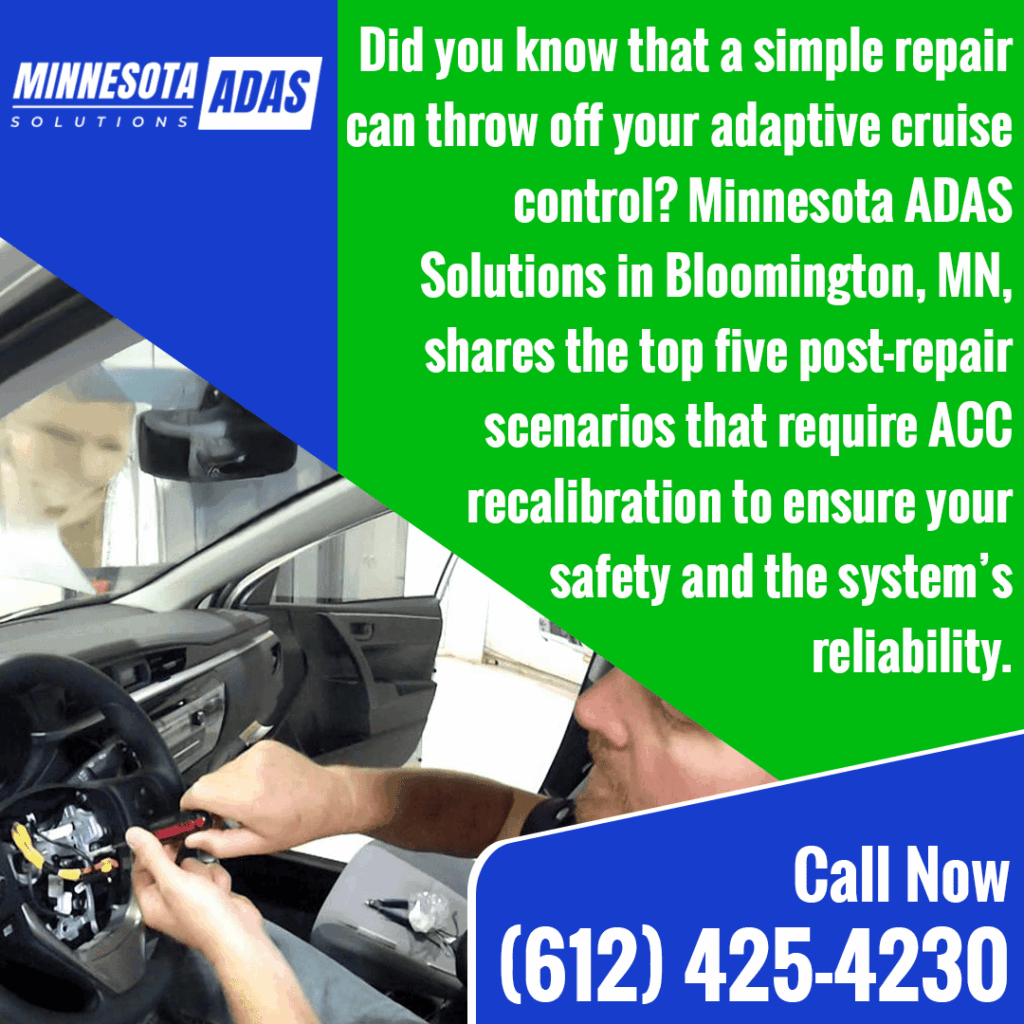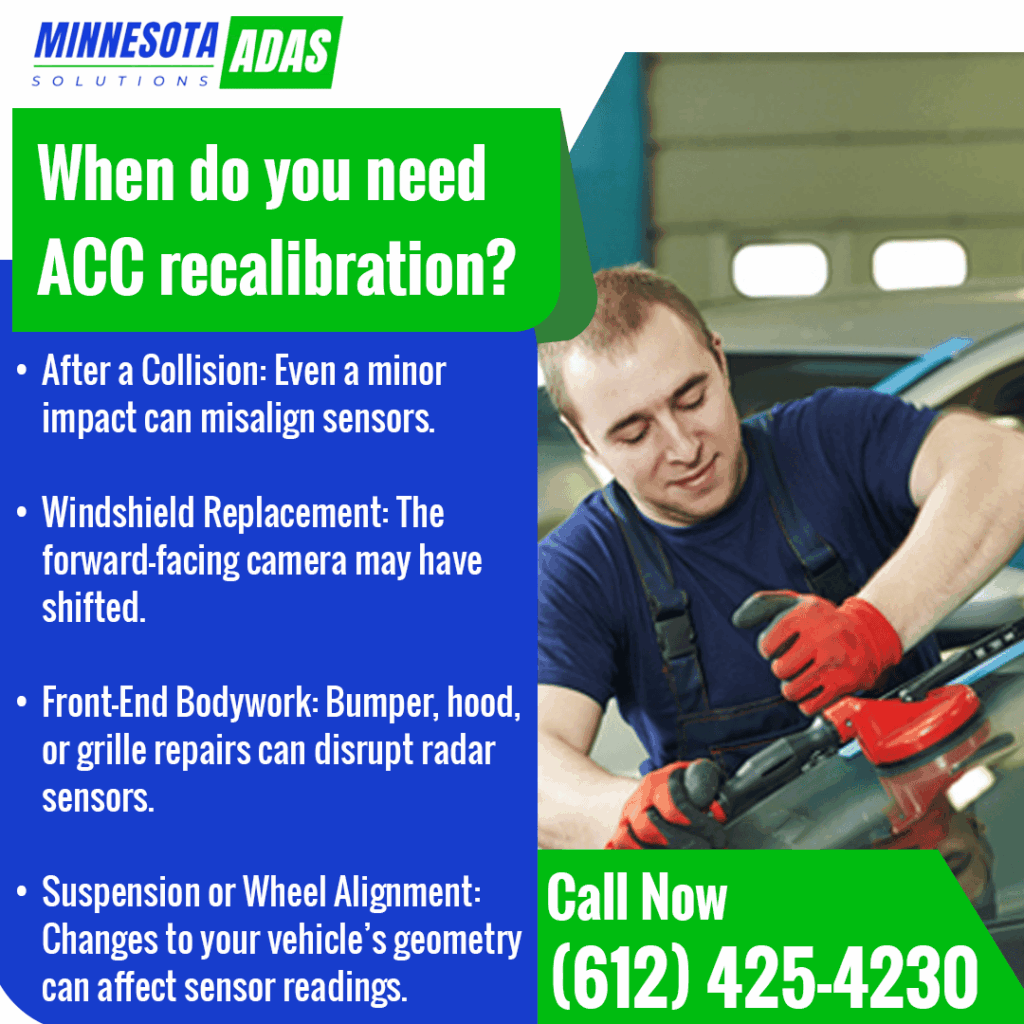Advanced driver-assistance technologies have transformed how we drive, and the adaptive cruise control system is a key feature that maintains safe distances and adjusts speed automatically. After repairs or maintenance, these systems can shift out of alignment, affecting performance and reliability. At Minnesota ADAS Solutions, we provide adaptive cruise control calibration in Bloomington, MN, to restore the precise operation of your vehicle’s sensors and cameras.
Whether your car has experienced a collision, windshield replacement, or front-end repair, our certified technicians handle every adjustment with accuracy. Taking action promptly after repairs helps you retain the full range of adaptive cruise control benefits, including smoother highway driving and consistent speed regulation. If you are searching for adaptive cruise control repair near you, our Bloomington facility delivers professional calibration services, thorough testing, and documentation for your vehicle. Driving with a properly calibrated system improves both safety and confidence on the road.

What is an Adaptive Cruise Control System?
An adaptive cruise control(ACC) system automatically adjusts vehicle speed to maintain a safe following distance. This system uses radar sensors and cameras to track the vehicles ahead. Unlike traditional cruise control, it can accelerate or brake without any input from you, maintaining a steady flow in traffic. Many vehicles integrate the ACC with other safety features like lane-keeping assist or automatic emergency braking. These connections give you benefits such as smoother highway driving, fewer speed fluctuations, and a reduced chance of rear-end collisions. Using ACC changes how you experience long drives, providing a driving experience that feels both controlled and responsive.
Why Recalibration Matters After Vehicle Repairs
Recalibration restores sensor and camera accuracy after vehicle repairs. Even small impacts or repairs can affect sensor alignment. Collisions, windshield replacements, and suspension work may shift cameras or radar units slightly, which can lead to delayed braking or unexpected alerts while driving. If your system reacts differently than it did before, it may indicate the sensors require attention. Recalibrating the system restores accurate detection of vehicles around you and keeps the adaptive features responsive, maintaining all the benefits you rely on for safe driving.
Overview of Common Post-Repair Impacts on ACC
Post-repair misalignment can affect ACC performance. Any work that changes the vehicle’s front-end structure, windshield position, or suspension can move sensors out of alignment. Even software updates or system resets may adjust how the ACC interprets input from cameras and radar. These changes can cause inconsistent speed adjustments or false alerts. Having the system checked and calibrated restores proper distance tracking, smooth acceleration, and integration with other vehicle safety systems. By taking the time to recalibrate, you help the ACC system respond accurately under all driving conditions.
Scenario 1: Collision or Accident Repairs
Minor collisions can have a bigger effect on your vehicle than you might realize. Even small impacts can disrupt the sensors that control your adaptive cruise control system, affecting how your car reacts on the road.
How Minor Collisions Affect ACC Functionality
Even minor accidents can misalign ACC sensors. Radar sensors and forward-facing cameras are designed to detect vehicles and objects with high precision. When a collision occurs, even at low speeds, these sensors can shift or tilt slightly. That change can alter how your ACC system interprets distance and speed. You may notice your car braking unexpectedly, accelerating at odd intervals, or sending warnings that don’t match traffic conditions. These issues directly reduce the adaptive cruise control benefits that you rely on for safe and comfortable driving.
Signs Your ACC May Be Misaligned After an Accident
Dashboard warnings or unusual braking indicate misalignment. You might see ACC-related alerts appear on your dashboard, or the system may not maintain a consistent speed with other vehicles. Your vehicle could slow down unexpectedly or fail to adjust properly in stop-and-go traffic. These signals indicate that your ACC system has been affected and requires calibration after the collision. Paying attention to these signs helps you maintain control and confidence while driving.
Steps for Post-Collision ACC Calibration
Certified facilities perform precise diagnostics and recalibration. At a certified center, technicians inspect the sensor positions and check camera alignment using advanced diagnostic tools. They adjust each component and run controlled tests to confirm the system responds correctly in different traffic scenarios. By choosing ACC calibration, you receive service that restores the system to factory specifications. This process allows you to regain full functionality of your ACC system and its intended performance on highways and city roads.
Scenario 2: Windshield Replacement or Glass Repair
Even small repairs to your vehicle’s windshield can affect the components that support your adaptive cruise control system. Drivers often overlook how sensitive the forward-facing cameras are and how even minor shifts can impact their performance.
Sensors and Cameras Affected by Windshield Changes
Windshield replacement can shift forward-facing cameras. Many of the cameras that control your ACC are attached directly to or positioned behind the windshield. During glass replacement, slight changes in alignment can occur. These adjustments may seem minor, but they can interfere with lane detection, distance monitoring, and automated braking responses. You might notice unusual alerts or changes in how your car responds to traffic if calibration is not addressed after the repair.
Importance of Accurate Recalibration for Safety Systems
Recalibration restores sensor alignment and system reliability. After the glass is replaced, professional technicians check the position of each camera and sensor and make precise adjustments. This process allows your ACC system to work as designed, maintaining consistent vehicle spacing and smooth braking. By having certified adaptive cruise control calibration, you protect the reliability of your safety systems and preserve the benefits you expect from the technology.
Scenario 3: Front-End Bodywork or Panel Replacement
Front-end repairs may seem straightforward, but even minor adjustments to your vehicle’s bumper, hood, or grille can affect the performance of your ACC system. Paying attention to sensor alignment after these repairs is necessary to maintain proper operation on the road.
How Bumper, Hood, or Grille Repairs Affect Radar Sensors
Front-end repairs can disrupt radar sensor accuracy. Radar sensors built into the bumper or grille track the distance and speed of vehicles ahead. If panels are replaced or adjusted during bodywork, the sensors can shift slightly, which may lead to delayed system responses or false alerts. This can interfere with smooth speed adjustments and reduce the adaptive cruise control benefits that help maintain safe distances on highways and in traffic.
Recalibration Procedures at Certified Facilities
Technicians measure, adjust, and test sensors in a controlled setting. At a certified facility like Minnesota ADAS Solutions, each sensor is carefully repositioned to match manufacturer specifications. Our technicians run tests and verify the system’s operation across multiple scenarios. Performing adaptive cruise control calibration in Bloomington, MN, restores factory alignment and confirms the ACC system operates correctly, allowing you to drive confidently with the intended sensor performance.
Scenario 4: Suspension or Wheel Alignment Adjustments
Suspension work or wheel alignment adjustments can subtly alter how your vehicle drives and how safety systems respond. Even small shifts in suspension geometry can change how sensors perceive the road, affecting the operation of your ACC system.
ACC Sensors Depend on Proper Vehicle Geometry
Vehicle geometry directly affects sensor calculations. Your ACC system relies on sensors to measure distances and monitor surrounding traffic. If the suspension height or wheel alignment changes, the vehicle’s reference points shift, which may cause the sensors to misread the environment. This can result in inconsistent braking, delayed speed adjustments, or uneven acceleration, making driving less predictable and more stressful. Accurate sensor positioning is necessary for smooth performance and for the system to adjust the vehicle’s speed effectively in different traffic conditions.
Why Calibration Is Needed After Suspension Repairs
Recalibration compensates for changes in vehicle alignment. After suspension or alignment work, technicians use specialized equipment to reposition the sensors so that they operate correctly. This calibration restores the system’s ability to maintain consistent following distances and respond properly to other vehicles. Completing this step after repairs keeps your ACC reliable and supports safe, controlled driving. At Minnesota ADAS Solutions, our certified team handles these adjustments with precision, making sure your vehicle operates at its designed performance level.
Scenario 5: Software Updates or System Resets
Software updates and system resets are common during vehicle maintenance or after certain repairs. These changes can affect the performance of your ACC system, and recognizing when recalibration is needed can help you maintain reliable operation.
Adaptive Cruise Control Requires System Synchronization
ACC relies on synchronized software and hardware. The adaptive cruise control system uses multiple sensors and cameras that communicate continuously with the vehicle’s control modules. If a software update or system reset occurs, the synchronization between these components can shift. This may lead to delayed braking responses, inconsistent speed adjustments, or false alerts from the system. Without proper recalibration, the ACC system cannot perform at its full capability, and the smooth driving experience you expect may be affected.
How Updates Can Affect Sensor Accuracy and Response
Recalibration restores correct system behavior after updates. After a software update, technicians check all sensor readings and adjust the settings to bring the system back into proper alignment. Each radar sensor and camera is tested to confirm the ACC responds appropriately to changes in traffic and road conditions. Performing ACC calibration guarantees that the system can maintain safe following distances, respond accurately, and work seamlessly with other driver-assistance features.

Choosing the Right Facility for ACC Recalibration in Bloomington, MN
Selecting the right facility for ACC recalibration affects how your ACC system performs after repairs. The facility you choose impacts both the accuracy of the calibration and the reliability of your vehicle’s safety features.
Advantages of Certified ADAS Calibration Centers
Certified facilities provide controlled, accurate recalibration. Facilities that follow original equipment manufacturer (OEM) procedures and use specialized calibration tools handle every adjustment with precision. These environments are designed to eliminate variables that could interfere with sensor alignment, helping the ACC system function properly. Accurate calibration keeps the system responsive and allows you to enjoy the full adaptive cruise control benefits, including smooth speed adjustments and consistent distance monitoring. By choosing a certified center, you reduce the risk of misalignment that can occur in general repair shops.
Minnesota ADAS Solutions’ Approach to ACC Calibration
Minnesota ADAS Solutions specializes in precise ACC calibration. At our Bloomington facility, we provide complete diagnostics, repair of damaged sensors or cameras, and precise sensor alignment. Most vehicles return to their owners within 90 minutes, with the ACC system fully tested. Using a certified service allows drivers to access adaptive cruise control repair near you without compromising system performance.
Detailed Documentation and Accuracy Verification
Every service includes thorough documentation and testing. Each calibration comes with a full record of adjustments and performance checks. These documents verify sensor alignment and system functionality for insurers, body shops, or vehicle owners. With adaptive cruise control calibration in Bloomington, MN, by Minnesota ADAS Solutions, you have confidence that the ACC system is calibrated according to manufacturer specifications.
Schedule ACC Calibration at Minnesota ADAS Solutions Today
Drivers in Bloomington can rely on certified ACC calibration services to keep their vehicles operating safely and accurately. Minnesota ADAS Solutions provides ACC calibration, expert sensor alignment, and complete documentation for every service. Call (612) 425-4230 or email info@mnadas.com to schedule an adaptive cruise control repair near you and restore your vehicle’s system to full functionality.
